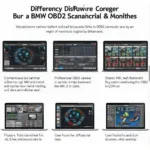Honda OBD2 fuel injectors play a crucial role in delivering the precise amount of fuel to your engine for optimal performance and fuel efficiency. Understanding their function, maintenance, and troubleshooting can save you time and money in the long run. This guide will delve into everything you need to know about Honda OBD2 fuel injectors.
Are you experiencing rough idling, poor fuel economy, or decreased engine power? These could be symptoms of faulty fuel injectors. Learning how to diagnose and address these issues is essential for maintaining the health of your Honda. This article explores common problems, diagnostic techniques, and replacement procedures for Honda OBD2 fuel injectors. Check out our guide on d16y8 obd2 honda fuel injectors for more specific information.
Understanding Honda OBD2 Fuel Injectors
Honda OBD2 (On-Board Diagnostics, Second Generation) fuel injectors are electronically controlled valves that atomize fuel into a fine mist for combustion. They receive signals from the Engine Control Unit (ECU), which determines the precise timing and duration of fuel injection based on various engine parameters like RPM, load, and temperature. This precise control ensures optimal air-fuel mixture for efficient combustion, maximizing power and minimizing emissions.
How Honda OBD2 Fuel Injectors Work
The ECU sends electrical pulses to the fuel injector solenoid, which opens and closes the injector valve. When the valve opens, pressurized fuel is sprayed into the intake manifold or directly into the combustion chamber. The duration of the pulse determines the amount of fuel injected. The ECU continuously adjusts this pulse width based on real-time engine data, ensuring the correct amount of fuel is delivered under all operating conditions.
Common Problems with Honda OBD2 Fuel Injectors
Over time, Honda OBD2 fuel injectors can experience various issues, including:
- Clogging: Fuel impurities or deposits can clog the injector nozzle, restricting fuel flow and affecting the spray pattern.
- Leakage: Worn seals or damaged components can cause fuel leaks, leading to poor fuel economy and potential fire hazards.
- Electrical Issues: Faulty wiring or a malfunctioning solenoid can prevent the injector from opening and closing properly.
- Sticking: Internal components can stick, causing the injector to remain open or closed, leading to overfueling or lean conditions.
You can find information about the electrical resistance of these components at honda obd2 fuel injectors resistance.
Diagnosing Honda OBD2 Fuel Injector Problems
Diagnosing fuel injector problems often involves using an OBD2 scanner to check for error codes related to the fuel system. You can further investigate by:
- Visually inspecting the injectors: Look for signs of leakage or damage.
- Checking fuel pressure: Low fuel pressure can indicate a problem with the fuel pump or clogged fuel filter, which can affect injector performance.
- Testing injector resistance: Use a multimeter to measure the resistance of the injector solenoid, which should fall within a specific range. Learn more at how many ohms are obd2 honda fuel injectors.
- Performing a fuel injector balance test: This test helps determine if each injector is delivering the correct amount of fuel.
Replacing Honda OBD2 Fuel Injectors
If you determine that one or more fuel injectors need replacement, the process generally involves:
- Relieving fuel pressure: Disconnect the fuel pump fuse or relay and crank the engine a few times to release pressure in the fuel lines.
- Disconnecting the fuel lines and electrical connectors: Carefully remove the fuel lines and electrical connectors attached to the fuel rail and injectors.
- Removing the fuel rail and injectors: Unbolt the fuel rail and carefully remove the injectors from the intake manifold.
- Installing new injectors and reassembling the components: Install the new injectors, ensuring they are properly seated and sealed. Reassemble the fuel rail, fuel lines, and electrical connectors.
For information on adapting injectors from different Honda models, visit honda obd2 to obd1 injector. Remember to always consult your vehicle’s service manual for specific instructions and torque specifications.
Conclusion
Honda OBD2 fuel injectors are essential for efficient engine operation. Understanding their function, common problems, and diagnostic procedures is key to maintaining your vehicle’s performance and fuel economy. By addressing these issues promptly and effectively, you can ensure your Honda runs smoothly for years to come.
FAQ
- What are the symptoms of bad Honda OBD2 fuel injectors? Symptoms include rough idling, poor fuel economy, decreased engine power, and misfires.
- How can I test my Honda OBD2 fuel injectors? You can test them using an OBD2 scanner, multimeter, or by performing a fuel injector balance test.
- How often should I clean my fuel injectors? It’s generally recommended to clean them every 30,000 to 60,000 miles.
- Can I replace Honda OBD2 fuel injectors myself? Yes, but it requires some mechanical knowledge and the proper tools.
- What is the average cost to replace a Honda OBD2 fuel injector? The cost can vary depending on the model and labor rates, but it typically ranges from $200 to $500 per injector.
- How can I prevent fuel injector problems? Use quality fuel, replace your fuel filter regularly, and consider using fuel injector cleaner periodically.
- What are the signs of a clogged fuel injector? Symptoms include rough idling, poor acceleration, and decreased fuel economy.
Need more help? You can check out information about honda obd2 fuel injectors resitance. You might also be interested in articles about other Honda OBD2 systems.
If you require further assistance, please don’t hesitate to contact us. You can reach our 24/7 customer support team via WhatsApp: +1(641)206-8880, Email: [email protected] or visit us at 789 Elm Street, San Francisco, CA 94102, USA.
